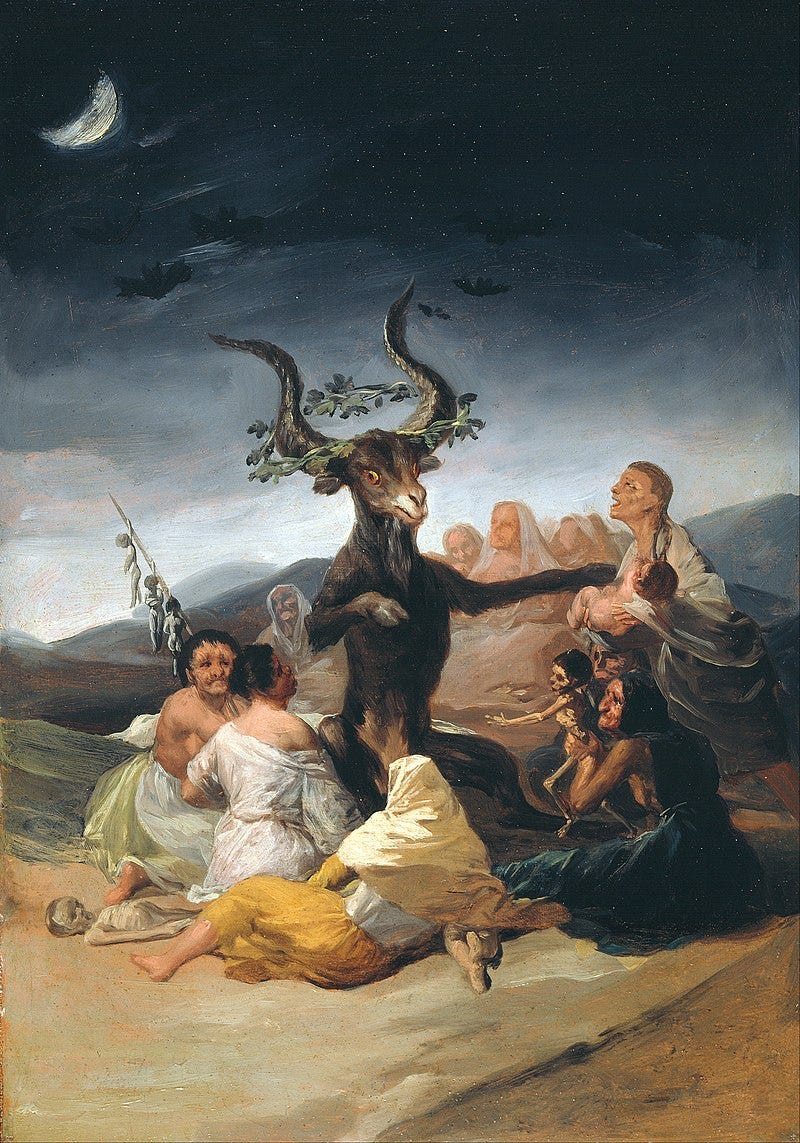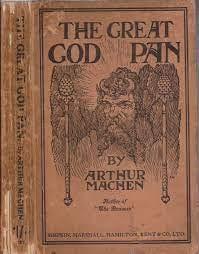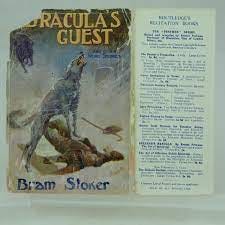Walpurgisnacht is almost here. If you are reading this, and if you are anywhere near the Harz Mountains in Germany, then you need to be careful. After darkness, on April 30th, witches, warlocks, and other traffickers in the diabolic arts gather among the high peaks to perform infernal rites to their satanic master. To the best of our knowledge, such rituals are being prepared as you read this—cauldrons, wands (TWU), and sacrificial victims are being secretly transported for their rendezvous on the Brocken.
The festival of Walpurgis Night possibly stems from pre-Christian Europe, when pagan tribes celebrated the coming of Spring and the abundance that came with it. Or, to crib more than a few notes from Carlo Ginzburg, the unlikely champion of European folk culture, it is possible that Walpurgis Night is a misunderstood application of folk Christianity, akin to the celebrations of Krampus or Perchta, which have next to no known connections to pre-Christian Alpine paganism. Anyway, what we do know is that the celebration got an official sanction from the Church in 8th century as a celebration of Abbes Walpurga, a canonized saint of Anglo-Saxon origin and a niece-by-marriage of Saint Boniface (he the famous Anglo-Saxon missionary who cut down the sacred tree). Given Saint Walpurga’s history and family connections, it is easy to speculate that the evil of Walpurgis Night is a celebration of the forces that she fought against and defeated. Thus, Walpurgis Night is like Mardi Gras—a double-faced honoring of both sin and the holy victory over it.
But enough with the egghead stuff. Walpurgis Night is a heavy metal holiday celebrated in Germanic Europe. As such, this special weekend deserves some recommendations from your favorite skull-face, Arbo. And as the direct descendant of a Frankish general in the Western Roman army, I feel that it is my duty to make sure that you enjoy this ancient Germanic festival in the best way possible.
All recommendations will come in threes, as that is the most blasphemous number.
Movies
It is pretty rainy where I am at right now, so I’m in a movie mode. And guess what? There are a lot of movies that touch on witchcraft and/or Walpurgis Night.
Häxan (1922)
Easily one of the most disturbing films ever committed to celluloid, Häxan is part horror movie and part ethnographic history. Crafted by the brilliant Danish filmmaker Benjamin Christensen (The Haunted House, Seven Footprints to Satan, The Mysterious Island), Häxan is a filmic essay about medieval demonology and witchcraft. As much as it titillates, the film does attempt to provide serious commentary on why Europe went witch-crazy, and what, if anything, contributed to the belief in widespread devil worship. (Well, you know, besides the fact that devil worshipping cults do exist.) Häxan also provides some of the most horrifying images of demonic activity, complete with early nudity, during a Black Mass sequence.
Dracula (1931)
This is the movie that birthed the horror film. Yes, there were other horror movies that came before it. And yes, if one is speaking only of vampire flicks, then Murnau’s Nosferatu is the far superior film. However, Tod Browning’s Dracula was a box office bonanza in 1931, and its popularity convinced Universal Studios that horror films were a guaranteed moneymaker. Without Dracula, there never would have been a major boom in horror films in the early 1930s, and without that first wave, there would have never been subsequent horror booms in the 1950s, 1970s, and beyond. Dracula is set on the eve of Walpurgis Night, and follows the British solicitor Harker (played by the great Dwight Frye) as he journeys to meet his enigmatic client, Count Dracula (Bela Lugosi). I’m sure you know the rest of the story, but suffice it to say that so much of the archetypal Dracula, from the Hungarian accent to the black cape and evening clothes, comes from this classic film.
The VVitch (2015)
Director Robert Eggers is a genius. That is not to be debated. What many debate is which of his fine films is his best. Some chose the cloying, insanity-inducing The Lighthouse. Others point to the The Northman, with its primal celebrations of Nordic-style revenge. For me, Eggers’s best film is his first. 2015’s The VVitch is a near-perfect presentation of Puritan New England’s unique relationship with the supernatural. The film follows a family that has been banished into the Massachusetts wilderness following a religious quarrel. The patriarch, William (Ralph Ineson), is a fundamentally good and God-fearing man who is nevertheless beset by evil forces beyond his control. These evil forces include a witch who lives deep in the woods, but she cannot compare to the evil influence that befalls one of William’s own children. With dialogue and imagery taken from 17th century court documents, The VVitch is proof positive that horror is deeply entrenched in the American psyche.
Music
Hellhammer, Satanic Rites (1983)
Before there was Celtic Frost, there was Hellhammer. The Swiss black metal trio influenced an entire sub-genre of music with three demos and an EP, all of which were released between 1983 and 1984. Hellhammer’s nasty and raw black metal is about as real as it gets, and all the Norwegian bands of the early 1990s name-checked Hellhammer as a serious influence. This compilation of all of Hellhammer’s demos is the perfect cacophony for bad things done after midnight. Bang your freakin’ head!
Deicide, Legion (1992)
Deicide’s second album has been controversial for some time now. It has its detractors, sure, but you cannot deny that Legion is one of the most technically complex and interesting death metal albums ever. And to quote a buff gentleman who knows a thing or two about death metal, “if you don’t like Deicide, you don’t like death metal.” Legion is chaotic, fast-paced, all-American death metal featuring songs with an obvious satanic character. If you’re throwing a Walpurgis Night beer bash, then put this vinyl on. All the devils and demons will beg for brew with their horns in the air.
Windhand, Soma (2013)
From the deep hollers of Appalachia, Windhand has been crafting ethereal and melodic doom metal for quite some time now. Led by the incredible vocals of Dorthia Cottrell, Windhand is a must-listen for anyone walking the darker side of life. Soma presents the band at their most raw and reverb-laden. Tracks like “Orchard” and “Woodbine” have the power to summon supernatural forces, so do not play them unless you are a level sixteen warlock or something. I don’t know about that nerd stuff, but I do know heavy metal, and Soma is about as good as it gets.
Short Stories
Arthur Machen, “The Great God Pan” (1894)
Welsh author Arthur Machen crafted one of the first cross-genre pieces in the history of weird literature. 1894’s “The Great God Pan” blends science fiction with fantasy and horror as it tells the story of Dr. Raymond. Obsessed with proving the existence of the supernatural, Dr. Raymond conducts an experiment on a young woman named Mary. The experiment is meant to open Mary’s mind to other worlds—an ancient process once called “seeing the great god Pan.” Well, as the experiment goes on, a new woman, the vile Helen Vaughan, enters the picture. Through Helen, Dr. Raymond and his friend, the narrator Clarke, uncover a horrific world of orgies, sacrifices, and pre-Christian gods interacting with modern peoples. “The Great God Pan” is Walpurgis Night in a nutshell, as it hints at an underworld much older and fouler than Christendom.
M.R. James, “Casting the Runes” (1911)
A huge influence on H.P. Lovecraft, M.R. James specialized in slow and chilling ghost stories. “Casting the Runes” departs from James’s usual fare, however. Set in contemporary England, the story concerns a rather unusual man named Karswell. The self-described alchemist and occultist Karswell has a grudge against several men who published negative reviews of his work. Using a slip of paper featuring ancient runes, Karswell uses a black magick curse in order to gain retribution. But curses can work both ways, and “Casting the Runes” shows the wages of sin. Later adapted as The Night of the Demon in 1957, “Casting the Runes” is James’s rare immersion into demonology, witchcraft, and the not-so-hidden influence of Aleister Crowley.
Bram Stoker, “Dracula’s Guest” (1914)
Published a few years after Bram Stoker’s death, “Dracula’s Guest” was originally intended to be the first chapter of Stoker’s immortal vampire novel. As a standalone short story, it hits the mark for weird menace. The story features Jonathan Harker, and it is set during his journey down the Danube to Transylvania. During a stop in Munich, Harker decides to take a stroll through an abandoned village. The village’s reputation as an unholy site proves true when supernatural entities begin to torment the young Englishman. Clearly influenced by J. Sheridan Le Fanu’s “Carmilla,” “Dracula’s Guest” is a subtle vampire story that proves that Stoker had plenty of power as a teller of shorter tales.
I hope you have enjoyed these recommendations, and I hope you make this weekend memorable. Just don’t accidentally summon Screwtape or his friends. Demons can be such self-hating bores, you know.
Tschüß.








